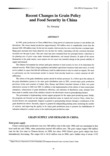Recent Changes in Grain Policy and Food Security in China
JIRCAS international symposium series
| ISSN | 13406108 |
|---|---|
| 書誌レコードID(総合目録DB) | AA1100908X |

本文フルテキスト
intlsymp-12_79-82.pdf145.36 KB
In 1999, grain production in China shifted from a long period of continuous increase to one decline and fluctuation. The recent annual production (approximately 450 million tons) is considerably lower than the demand (480-490 million tons). In the last two months, food security has once more become a common topic. Sharp price increases have been observed over the last two weeks, contrasting with the consistent decreases recorded over the past 6 years. This new trend may have stemmed from two principal factors: reductions in the planting area of grain crops under structural adjustments, and natural disasters. In spite of the recent fluctuations in the grain market, most analysts do not expect any essential change in the present stability of supply and demand.
The Chinese Government has always paid great attention to food security in view of its importance for national security. With China's large population and limited agricultural resources (land and water), it would not be realistic to expect that full self-sufficiency could be achieved nor to rely too much on imports. We need to judiciously use the international market to ensure food security based on a certain measure of self-sufficiency.
The reform of the grain distribution system should be further promoted. In a follow-up to the reform of the grain distribution system in the main grain distribution areas in 2001, several major grain production provinces (cities and counties of Anhui, Jilin, Henan, and Hubei) launched reforms of their own grain distribution systems in 2002 and 2003. In addition to the implementation of the reform of state-owned grain enterprises, enhancement of grain distribution efficiency, and reduction of distribution costs, attempts have been made to transfer some of the subsidies related to the distribution issues to grain-planting farmers.
The government is implementing various support programs for the major grain-producing areas. Firstly, the programs are focused on the major grain production areas in central and western China, where low-income farmers are concentrated. Support is granted to grain-planting farmers through a combination of the grain distribution reform. Secondly, support is granted for safeguarding planting areas, increasing the number of varieties, and improving the quality in the major grain production areas to promote the establishment of industries related to a certain variety in the traditional grain production areas.
The Chinese Government has always paid great attention to food security in view of its importance for national security. With China's large population and limited agricultural resources (land and water), it would not be realistic to expect that full self-sufficiency could be achieved nor to rely too much on imports. We need to judiciously use the international market to ensure food security based on a certain measure of self-sufficiency.
The reform of the grain distribution system should be further promoted. In a follow-up to the reform of the grain distribution system in the main grain distribution areas in 2001, several major grain production provinces (cities and counties of Anhui, Jilin, Henan, and Hubei) launched reforms of their own grain distribution systems in 2002 and 2003. In addition to the implementation of the reform of state-owned grain enterprises, enhancement of grain distribution efficiency, and reduction of distribution costs, attempts have been made to transfer some of the subsidies related to the distribution issues to grain-planting farmers.
The government is implementing various support programs for the major grain-producing areas. Firstly, the programs are focused on the major grain production areas in central and western China, where low-income farmers are concentrated. Support is granted to grain-planting farmers through a combination of the grain distribution reform. Secondly, support is granted for safeguarding planting areas, increasing the number of varieties, and improving the quality in the major grain production areas to promote the establishment of industries related to a certain variety in the traditional grain production areas.
| 作成者 | Xiaoqing Xu |
|---|---|
| 公開者 | Japan International Research Center for Agricultural Sciences |
| オンライン掲載日 | |
| 号 | 12 |
| 開始ページ | 79 |
| 終了ページ | 82 |
| 言語 | eng |
